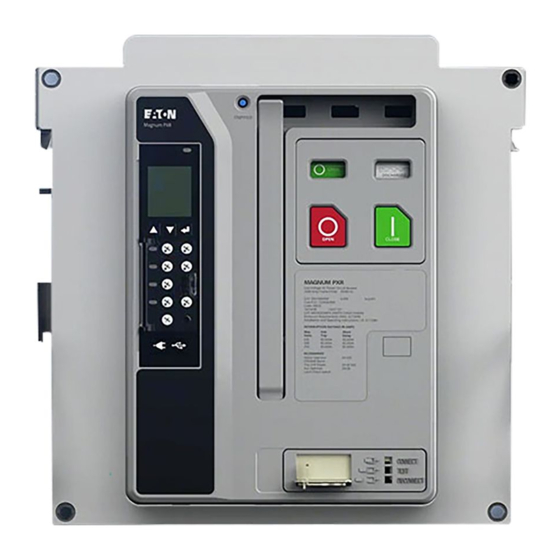Table of Contents

Summarization of Contents
Section 1: Introduction
Purpose
Describes the manual's scope and objectives for installation, operation, and maintenance.
Safety
General safety guidelines and precautions for working with equipment.
General information
Overview of breaker types, ratings, and basic construction.
Safety features
Built-in safety mechanisms designed to reduce hazards.
Safety practices
Procedures for safe installation, operation, and maintenance.
Section 2: Receiving, handling, and installation
Qualified personnel
Requirements for personnel working with electrical equipment.
Other publications and documentation
List of related documents and resources for further information.
General information
Initial steps for receiving and handling circuit breakers.
Suggested tools
List of recommended tools for installation and maintenance.
Unpacking the circuit breaker
Procedures for safely unpacking circuit breakers.
Storing the circuit breaker
Guidelines for proper storage of circuit breakers.
Lifting circuit breaker
Procedures and precautions for safely lifting circuit breakers.
Installing the drawout circuit breaker
Steps for installing drawout type circuit breakers into their cassettes.
Rejection interlocks
Explanation of compatibility features to prevent incorrect breaker insertion.
Circuit breaker positioning
Describes the different positions (REMOVE, DISCONNECT, TEST, CONNECT) of drawout breakers.
Levering circuit breaker
Operation of the drawout mechanism for moving breakers.
Fixed circuit breaker
Characteristics and features unique to fixed mount breakers.
Section 3: Circuit breaker description and operation
Introduction
Overview of common features across different breaker types.
Basic circuit breaker assembly
Details of the breaker's construction and materials.
Pole units
Description of individual pole units and their components.
Primary moving contacts
Details on the contact finger assemblies and connections.
Primary stationary contacts
Description of fixed contacts, arc runners, and arc chute interface.
Operating mechanism
How the breaker operates manually and electrically.
Electrical operation
Details on electrically operated breakers and their functions.
Arc chambers
Function and structure of arc chambers for insulation and arc control.
Electronic tripping system
Components and function of the PXR trip unit.
Microprocessor-based trip unit
Capabilities and features of the PXR trip unit.
Accessory devices
Overview of available optional accessories for breakers.
Shunt trip
Description of the shunt trip accessory and its function.
Spring release
Description of the spring release accessory for remote closing.
Undervoltage release
Description of the undervoltage release accessory.
Auxiliary switch
Function and application of auxiliary switches.
Motor operator
Details on the motor operator accessory for automatic operation.
Mechanical accessories
List of optional mechanical accessories for breakers.
Operations counter
Function of the operations counter to record breaker operations.
Off key lock
Function of the off key lock to secure the breaker in the OFF position.
Cassette lock
Function of the cassette-mounted lock for interlocking schemes.
Pushbutton cover
Padlockable covers to limit access to OPEN/CLOSE pushbuttons.
Cassette safety shutters
Automatic insulating shutters for primary contacts.
Cassette cell switch
Compartment position switch for drawout circuit breakers.
Door escutcheon
Molded frame to seal the space between breaker and compartment door.
Mechanical interlock
Systems for interlocking two or three breakers to prevent simultaneous closing.
Secondary contacts and connection diagrams
Details on secondary wiring and connection points.
Connection diagrams
Wiring diagrams for Magnum PXR and PD-SB breakers.
Section 4: Master connection diagrams
Secondary contacts and connection diagrams
Details on secondary wiring and connection points.
Connection diagrams
Specific wiring diagrams for PXR trip units.
Section 5: Drawout circuit breaker and cassette
General
Introduction to features unique to drawout breakers and cassettes.
Drawout cassette
Description of the fixed drawout cassette and its interfaces.
Drawout circuit breaker dimensions
Physical dimensions of the drawout circuit breaker.
Drawout cassette dimensions
Physical dimensions of the drawout circuit breaker cassette.
Section 6: Fixed circuit breaker
General
Introduction to features unique to fixed circuit breakers.
Fixed circuit breaker dimensions
Physical dimensions of the fixed circuit breaker.
Section 7: Importance of maintenance
General
Rationale for performing regular inspection and maintenance.
Safety precautions
Safety warnings and requirements for maintenance personnel.
General cleaning recommendations
Guidelines and methods for cleaning circuit breakers.
Functional tests
Recommended tests to check basic breaker component functionality.
Manual operation functional test
Test procedure for manually operating the breaker.
Electrical operation functional test
Test procedure for electrically operated breaker functions.
Trip unit overload functional test
Testing the trip unit's overload response using software.
Maintenance schedule
Recommended schedule for breaker inspections and tests.
Normal operating conditions
Environmental and operating factors affecting maintenance frequency.
Adjusting maintenance frequency
Factors that may require an increased inspection frequency.
Inspection procedures
Step-by-step guides for performing various breaker inspections.
Arc chute inspection
How to inspect arc chutes for damage or dirt.
Primary contact inspection
How to inspect primary contacts for wear and damage.
Internal mechanism inspection
Procedures for inspecting internal breaker parts.
Secondary disconnect inspection
How to inspect secondary connections and pins.
Interlocks inspection
Testing of mechanical and electrical interlocking mechanisms.
Section 8: Renewal parts
General
Information on obtaining renewal parts and spare parts.
Disclaimer of warranties and limitation of liability
Legal disclaimers regarding product use and warranty.











Need help?
Do you have a question about the SPS-630 and is the answer not in the manual?
Questions and answers